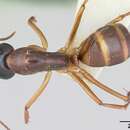en
names in breadcrumbs


Taxonomic history
Emery, 1893k PDF: 674 (m.); Wheeler & Wheeler, 1968a PDF: 216 (l.).Combination in Camponotus (Camponotus): Emery, 1925d PDF: 74.Junior synonym of Camponotus castaneus: Mayr, 1886d PDF: 420.Revived from synonymy as subspecies of Camponotus castaneus: Emery, 1893k PDF: 674; Wheeler, 1913d PDF: 117; Wheeler, 1917k PDF: 465; Wheeler, 1932a PDF: 13.Revived status as species and senior synonym of Camponotus rufinasis: Creighton, 1950a PDF: 365.See also: Eisner & Wilson, 1952 PDF: 47.[[ worker ]] Laenge 13 mm- Ziemlich glaenzend, der Thorax und die Schuppe dunkelbraun, der Kopf und Hinterleib schwarz, die Beine, die Basis und das Ende des Schaftes, so wie die Geissel lichtbraun,. die Mandibeln rothbraun. Die abstehende Behaarung ist am Kopfe und Hinterleibe sparsam, auf letzterem in Reihen, am Thorax sehr spaerlich, die Schenkel sind nur mit einzelnen Borstenhaaren besetzt; die anliegende Pubescenz ist weisslich und aeusserst spaerlich, nur bei starker Vergroesserung und guenstiger Beleuchtung sichtbar. Die Mandibeln sind 5 - 6 zaehnig, weitlaeufig grob punctirt. Der Clypeus ist ungekielt, vorne nicht lappig erweitert, der Vorderrand schwach gerundet und nicht ausgerandet. Der Kopf und der Thorax sind sehr dicht und aeusserst fein netzartig und lederartig gerunzelt. Die Schuppe ist genau so wie bei C. ligniperdus breit eifoermig, vorne etwas staerker als hinten gewoelbt, der Rand ist ziemlich dick und ist oben nicht ausgerandet. Der Hinterleib ist sehr fein und dicht quergestreift.
[[ queen ]] Laenge 15 mm. Kopf und Hinterleib schwarz, Mandibeln, Thorax, Hueften und Schenkel rothbraun, Schienen und Tarsen dunkler, Schildchen schwaerzlich und Geissel gelbbraun. Die abstehende Behaarung ist sehr spaerlich, ebenso die anliegende Pubescenz, welche auf der Scheibe des Thorax vollkommen fehlt. Die Skulptur der Koerpertheile ist wie beim [[ worker ]]. Der Thorax ist ziemlich kurz, breit und oben flach. Die Schuppe ist aehnlich der des [[ worker ]], aber groesser, besonders breiter und oben mit geradem etwas schneidigem Rande.
Aus Neu-Orleans in Nordamerika im kais. zoologischen Kabinete in Wien.
Camponotus americanus is a species of carpenter ant. The ant is above average in length with worker ants being 7–10 mm (0.28–0.39 in) long. Despite normally nesting in soil, it is known that the species may nest under stones, under litter, or in rotten logs.[1]
Camponotus americanus is a species of carpenter ant. The ant is above average in length with worker ants being 7–10 mm (0.28–0.39 in) long. Despite normally nesting in soil, it is known that the species may nest under stones, under litter, or in rotten logs.